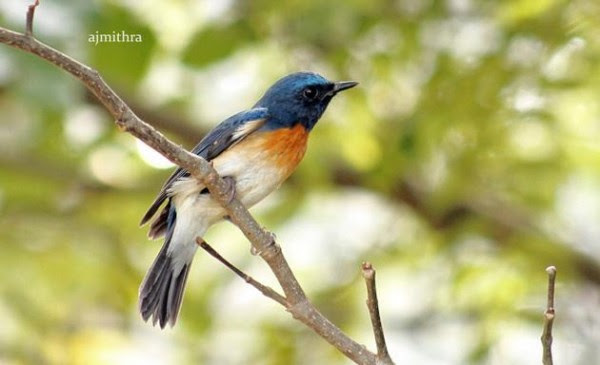Carnatic Music Raga Notes Discernible in the Tuneful Sounds of Birds
23 January 2014, 10:42 pmBy
Hema VijayFrom koels and flycatchers to magpie robins and whistling thrushes, birds seem to have their own concerts with raga and thala intact — think Mohanam, Bilahari, Kalyani and kanda chapu thaalam! Hema Vijay sets out to learn more about their melody- and rhythm-based tweetsSpecial Arrangement Life’s A Song: Cuckoo
The city’s annual musical extravaganza may have just winded up, but plenty of complex music still hangs in the air — thanks to the city’s diverse birds and their sweet songs.
To the untrained ear, bird calls may sound like noises in different pitches and tones. For that sound to be perceived as a melody and translated into a scale, one does need a fair amount of musical training. But could there be a definite raga in the chirps and tweets?
“Bird songs, too, are in different ragas. For example, koels tend to choose Shankarabaranam. The Malabar whistling thrush, a versatile singer, sings very complicated phrases, and is heard singing in Mohanam and Bilahari. The orange-headed ground thrush can be heard singing in Kalyani. Indian robins are heard singing to kanda chapu thaalam, the 5/8 time signature in Western music,” says A.J. Mithra, music teacher, zoo musicologist, and someone who has been studying bird calls for several years now. As in Indian classical music, birds use microtones in their songs. This creates a great degree of musicality in their songs, Mithra points out.In a sense, the perception of a raga in a birdcall could be a subjective matter too. “I never heard anything as beautiful as the whistling thrush I heard during a camping holiday in the hills. And when I hear the koel sing, I hear the basic sa-pa-sa in its song. When the cuckoo oscillates its songs, I hear a few distinct notes in it, representative of raga Suddha Dhanyasi. But bird calls could translate to different ragas to different people. That is because we identify a raga in the bird call, based upon the pitch we take from its call as its base note. For instance, a pentatonic raga like Mohanam can become Madhyamavathi or Hindolam, if I take a different base note in the song,” remarks Carnatic vocalist Sikkil Gurucharan.Special Arrangement Life’s A Song: Indian robinMoving further, it becomes clear that musical improvisations of a basic tune are not the prerogative of Carnatic maestros alone. “Birds such as the Oriental magpie robin and Tickell’s blue flycatcher improvise their songs all the time. Sometimes, within the same morning, they may improvise their basic song with up to 20 variations,” mentions Mithra. Another point he makes is that birds use the ambience pitch to sing their song, the way Carnatic vocalists use the tanpura to help them sing in pitch.Special Arrangement Life’s A Song: Koel
“When the frequency of the background sound rises, the birds raise the pitch of their songs too,” Mithra says. Meanwhile, the saptaswaras or the seven notes — Sa, Ri, Ga, Ma, Pa, Dha, Ni, in Indian Classical music, are considered by many to be inspired by the call of both birds and animals such as peacock, dove, cuckoo, frog, and elephant, while ragas such as Hamsadhvani are considered to have been inspired directly by birds.Complex ragas evolved over centuries, taking cues from Nature’s sounds, ranging from incoherent sounds such as that of the wind, the waves and the rain, to the precise and modulated phrases of birds. Further, birdsongs have inspired compositions in the Western operatic tradition too. Says Anil Srinivasan, Classical pianist, “For instance, French composer Louis-Claude Daquin’s ‘Le coucou’ (The Cuckoo) played in a higher octave sounds exactly like a cuckoo’s cry.Special Arrangement Life’s A Song: Oriental Magpie Robin Photo: A.J. MithraSpecial Arrangement Life’s A Song: Skylark Photo: A.J. Mithra‘La Gazza Ladra’ (The Thieving Magpie) by Giuseppe Verdi sounds like the magpie’s song, and Robert Schumann’s ‘Vogel als Prophet’ (The Prophet Bird) lets you hear forest birds’ calls. Then, of course, there is Mozart’s ‘The Magic Flute’ composed as a duet between a male and female parakeet. It sounds exactly like the parakeet’s songs.”Special Arrangement Life’s A Song Tickell’s blue flycatcher. Photo: A.J. Mithra
Well, the perception of ragas in bird songs might be either the cause or the effect of mankind’s musical endeavours. But either way, bird songs do remind us that an evolved sense of aesthetics and musical finesse are not exclusive to us humans alone. courtesy: The Hindu

This blog is about the entrants in the year 1960, to the Faculty of Medicine, University of Ceylon, Colombo. The email address for communications is, 1960batch@gmail.com. Please BOOKMARK this page for easier access later.Photo is the entrance porch of the old General Hospital, Colombo, still in existence. Please use the search box below to look for your requirement.
Sunday, January 26, 2014
Singing birds - email from Dawood.
Subscribe to:
Post Comments (Atom)









No comments:
Post a Comment